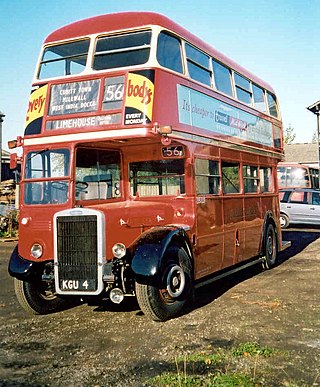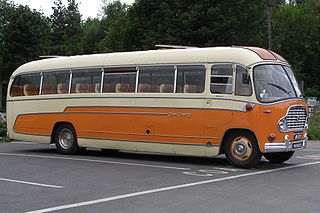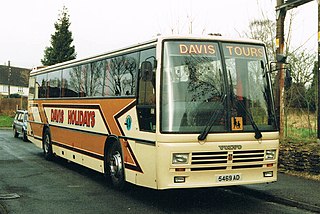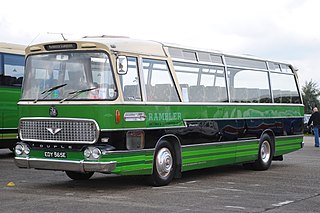
The Chevrolet Lumina APV is a minivan that was produced by the Chevrolet division of General Motors. The first front-wheel drive minivan sold by Chevrolet, the Lumina APV was sold in a single generation from the 1990 to 1996 model years. Marketed alongside the Pontiac Trans Sport and Oldsmobile Silhouette, the Lumina APV competed against the Dodge Grand Caravan/Plymouth Grand Voyager, the extended-length Ford Aerostar, and the Mazda MPV.
Plaxton is an English builder of bus and coach vehicle bodies based in Eastfield, Scarborough, England. Founded in 1907 by Frederick William Plaxton, it became a subsidiary of Alexander Dennis in May 2007. In 2019, the maker was acquired by Canadian bus manufacturer New Flyer which then became NFI Group.

The Leyland Titan was a forward-control chassis with a front-mounted engine designed to carry double-decker bus bodywork. It was built mainly for the United Kingdom market between 1927 and 1942, and between 1945 and 1969.

Duple Coachbuilders was a coach and bus bodybuilder in England from 1919 until 1989.
Bedford Vehicles, usually shortened to just Bedford, was a brand of vehicle manufactured by Vauxhall Motors, then a subsidiary of multinational corporation General Motors. Established in April 1931, Bedford Vehicles was set up to build commercial vehicles. The company was a leading international lorry brand, with substantial export sales of light, medium, and heavy lorries throughout the world.

The Bedford OB was a bus chassis manufactured by Bedford from 1939.

The Daimler Fleetline is a rear-engined double-decker bus chassis which was built between 1960 and 1983.

The Duple Dominant was a design of a coach bodywork built by Duple between 1972 and 1987. It introduced an all-steel structure and replaced the wooden-framed Duple Vega, Viceroy and Vista models.

The Bedford CA was a distinctive pug-nosed light commercial vehicle produced between 1952 and 1969 by Bedford in Luton, England.

The Leyland Panther Cub was a rear-engined single-decker bus manufactured by Leyland from 1964 until 1968.

The Bedford SB was a front-engined bus chassis manufactured by Bedford in England. It was launched at the 1950 Commercial Motor Show as the replacement for the Bedford OB.

The Leyland Tiger was a heavyweight half-cab single-decker bus and coach chassis built by Leyland Motors between 1927 and 1968, except the period of World War II.
H. V. Burlingham was a British coachbuilding business based in Blackpool, Lancashire from 1928 until 1960 when they were taken over by London-based rivals Duple Motor Bodies. Duple initially renamed Burlingham as Duple (Northern) but in 1969 they closed their Hendon factory and concentrated production in Blackpool. Duple coach bodies were built in the former Burlingham premises until Duple itself was liquidated in 1989.

The Leyland Royal Tiger Worldmaster, sometimes simply known as the Leyland Worldmaster, was a mid-underfloor-engined single-decker bus or single-decker coach chassis manufactured by Leyland between 1954 and 1979.

The Chevrolet Van or Chevy Van is a range of vans that was manufactured by General Motors from the 1964 to 1996 model years. Introduced as the successor for the rear-engine Corvair Corvan/Greenbrier, the model line also replaced the panel van configuration of the Chevrolet Suburban. The vehicle was sold both in passenger van and cargo van configurations as well as a cutaway van chassis that served as the basis for a variety of custom applications.

The Bristol LH was a single-decker bus chassis built by Bristol Commercial Vehicles (BCV) in Bristol, England. Nearly 2,000 were built between 1967 and 1982 in a variety of sizes and body types, including some as goods vehicles.

The Leyland Royal Tiger PSU was an underfloor-engined bus and coach chassis manufactured by Leyland between 1950 and 1954.

The Bedford Y series was a family of single-decker bus and single-decker coach chassis manufactured by Bedford from 1970 to 1986, when Bedford ceased bus and truck production.

The Duple 300 Series were a range of bus and coach bodywork built by Duple between 1985 and 1989. The range comprised the 3,000 mm high Duple 300 service bus, the 3,200 mm high Duple 320 coach, and the taller 3,400 mm high Duple 340 coach. The 320 and 340 coaches were announced at the Bus and Coach Show at Earls Court in September 1985 as replacements for the previous Laser and Caribbean. Deliveries of these models commenced in 1986, whilst the 300 bus was launched in 1987 as a replacement for the Dominant Bus. After Duple closed down the designs were sold to Plaxton and a small number of additional 320 bodies were built as the Plaxton 321.

The Duple Viceroy was a type of coach bodywork built by Duple between 1966 and 1972. It was initially launched on lightweight front-engined chassis, but it was latterly built on mid-engined and heavyweight chassis as well. A variant of the Viceroy was the Duple Viceroy Express, which had a bus-type entrance door making it suitable for stage carriage work.

















